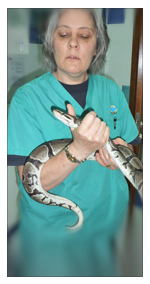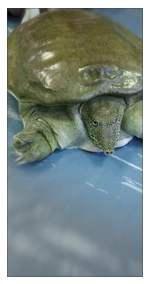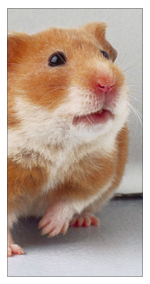|
|
 Boas should be housed individually, except during breeding attempts. Enclosures for juvenile boas should be at least 61 cm (24 in) long and 38 to 61 cm (15 to 24 in) high. Adult boas should be housed in enclosures at least 1.8 m (6 ft) long, 61 cm (24 in) wide, and at least 61 cm (24 in) high. Larger cages provide better opportunities for establishing a proper thermal gradient. Boas should be housed individually, except during breeding attempts. Enclosures for juvenile boas should be at least 61 cm (24 in) long and 38 to 61 cm (15 to 24 in) high. Adult boas should be housed in enclosures at least 1.8 m (6 ft) long, 61 cm (24 in) wide, and at least 61 cm (24 in) high. Larger cages provide better opportunities for establishing a proper thermal gradient.
Click here to get more care advice for your Boa
|
|
|
 Soft-shelled turtles, are found in nearly every type of waterway in the world. Every continent with the exception of Australia and Antarctica is host to this unique family. Soft-shelled turtles died out in Australia in the Pleistocene, around 40,000 years ago. Soft-shelled turtles, are found in nearly every type of waterway in the world. Every continent with the exception of Australia and Antarctica is host to this unique family. Soft-shelled turtles died out in Australia in the Pleistocene, around 40,000 years ago.
Every species of soft-shell is slightly different in terms of it's particular needs and maintenance which is not surprising in a family with species that may range in size as adults from 20 cm to 200 cm. This care sheet is intended only to cover the general care of this turtle family. Further research to best develop a maintenance plan for whichever species you are caring for is essential.
Click Here for more information
|

|
|
|
Natural History
Red-eared Sliders (Trachemys scripta) are found throughout the United States east of the Rockies. The subspecies T. s. elegans, yellow-bellied slider, is the one most often sold in pet stores here and abroad. These fresh water turtles spend much of their time in the warm waters of their native habitat. While they are strong underwater swimmers, these sliders spend much of the warmer hours of the day hauled out on logs or rocks (or, when very small, on marsh weeds and other aquatic plants) basking in the sun.
All of the sliders are omnivores, eating both animal protein and vegetable / plant matter. Younger turtles need up to 40% of their food from protein sources; adult turtles feed more heavily on vegetation. In the wild they begin by eating tiny fish and amphibian larva, water snails and a variety of plants growing in the water and on land.
Click Here to read more about their natural history and care.
|

|
|
|
Tortoises will not tolerate climates that have a relative humidity in excess of 50% for extended time periods. Tortoises are extremely susceptible to a disease referred to as Upper Respiratory Tract Disease (URTD)-(See Health section), and high humidity seems to be a factor in the development of this condition. Tortoises have the reputation of a difficult captive, and they are. Providing desert tortoises with the right captive conditions is not impossible, but does take significant effort.
This species is not as forgiving of husbandry errors as other tortoise species such as the African spur-thighed tortoise. Provided with the correct captive conditions however, a tortoise pet may well outlive its owner. Tortoises are best housed outside in conditions similar to their natural habitat.
Click Here to read more about their nature & care.
|
|
|
 Introduction: Introduction:
The green iguana is a lizard native to Central and South America. They are daylight active (diurnal) and dwell in trees (arboreal). Their day is spent foraging for food and basking in trees. With appropriate care most iguanas can live 10 - 15 + years and reach 6 feet or more in length.
Environment:
Housing is one of the first considerations in keeping your iguana happy. It is best to start with a high 20 or a 29 gallon tank, but expect to purchase or build a larger cage in the future. Iguanas grow fairly quickly and under the right conditions, can grow to be 2 feet at 1 year of age. At 6 feet, they will require a sizable enclosure.
Click Here to read more about their enviroment & care.
|

|
|
|
The chinchilla is a domesticated rodent that originally lived in the high Andes Mountain region of South America. The chinchilla was hunted to near extinction in the early 1900's. Most of the chinchillas in the United States today are descendants of 11 animals brought to California in 1923.
Chinchillas can make great pets. Initially, it is the chinchilla's beautiful coat that attracts attention; however, it is this docile animal's personality that ultimately wins over it's many friends.
Click Here to read more on its Housing and Environment, Diet, Handeling and, Common Diseases and Syndromes.
|

|
|
|
The guinea pig or cavy is a docile rodent native to the Andes Mountain area of South America. They were first domesticated by the Andean Indians of Peru who used them as a food source and as a sacrificial offering to Incan gods. During the 16th century, Dutch explorers introduced guinea pigs to Europe where they were selectively bred by fanciers. To this day, the guinea pig remains a favorite pet among children due to their docile behavior, ease of handling, and clean, quiet nature.
Click Here to learn more on its Housing and Environment, Diet, Handeling and, Common Diseases and Syndromes.
|
|
|
 Hamsters are peculiar little rodents with large cheek pouches and short stubby tails. The Syrian hamster's (golden hamster) wild habitat extends through the Middle East and Southeastern Europe. Hamsters are peculiar little rodents with large cheek pouches and short stubby tails. The Syrian hamster's (golden hamster) wild habitat extends through the Middle East and Southeastern Europe.
Since their domestication, several color and hair coat varieties of the Syrian hamster have arisen through selective breeding. The three basic groups which now exist include the common 'golden' hamster, colored short-haired 'fancy' hamster, and long-haired 'teddy bear' hamster.
On occasion, one may encounter other species of hamsters, but these are much less common than the Syrian hamster.
Click Here to learn more on its Housing and Environment, Interesting Facts, Diet, Handeling and, Common Diseases and Syndromes.
|

